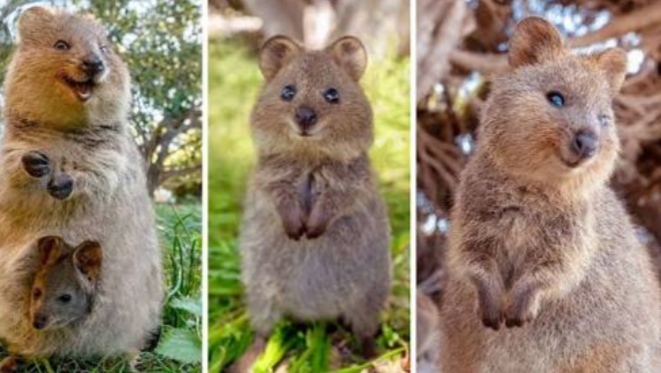Who is the world’s happiest animal?
It’s Quokka!
Quokka’s are part of the kangaroo and wallaby family, which in size is like a domestic cat with the tail of a rat. They are also called short tailed wallabies. They are herbivores in nature and mainly nocturnal. Usually they feed on leaves, stems, and bark of plants. Therefore it’s simply easy to impress quokkas even with a tasty leaf. But they are also capable of surviving without food or water for a longer period as they have fat stored in their rat tail. Male quokkas are dominant; they weigh around 4.5kgs while the female weights around 3.5kgs.
Did you know?
Female quokkas can give birth twice a year. They breed from the month of January to August. They give birth to young ones after a month of gestation. Quokkas get mature enough to give birth at the age of 1.5years while it’s lifespan is 10 years. “Joey” is the young one of quokka that lives in the pouch of mother quokka for a period of 6 months. The baby quokka is reliant on mother’s milk for around 2months after birth.
Why are they crowned as happiest among all the animals in the world?
Unlike other wild animals, quokkas have an evolutionary smile on their face which makes them look like they are happy all the time. Quokkas are mainly found in Australian Islands such as Rottnest Island, Bald Island and a few other islands in western Australia. Rottnest is one such island that is named after quokkas.
A Dutch visitor “Willem de Vlamingh” visited the island in the year 1696. He found these quokkas and thought they were large rats and therefore he named the island as “Rattennest” which meant ” Rat’s Nest” in Dutch. The largest population of quokkas is found on this island.
Social media has played a vital role in popularising Quokkas….
Quokkas are the main attraction to the tourists visiting Rottnest Island while they cause a little trouble to the local people living on the island. These adorable Australia quokkas are going viral on the internet recently. These quokkas are very friendly and exciting, they enjoy taking pictures with humans rather than getting scared. Social media is flooded with amazing quokka pictures and selfies. Their cuteness might make you feel like keeping them as pets but sadly it’s restricted. Incase if you visit the island beware of touching and feeding quokkas as they are vulnerable species, they might also use their sharp claws and teeth against you if they feel threatened. Therefore kindly maintain distance (using a selfie stick would be better if you wish to take selfies). You may end up paying a fine of around 150- 300 dollars if you violate the rules.
Threats to quokka population:
According to the Department of Parks and Wildlife(DPAW) the key threat to quokkas population were feral animal predation of foxes, dogs or cats on the mainland, bushfires, climatic changes, habitat fragmentation through permanent disturbance and logging.
By: Aishwarya Shivakumar

